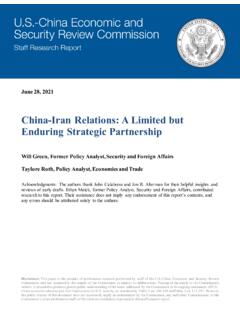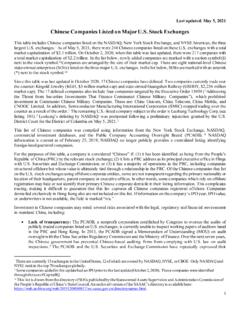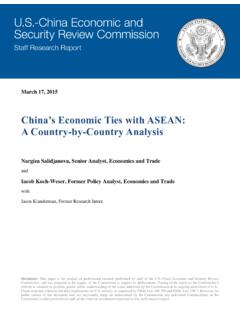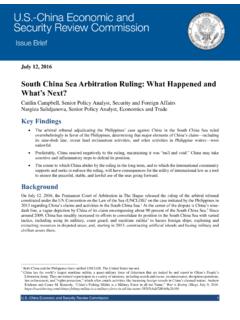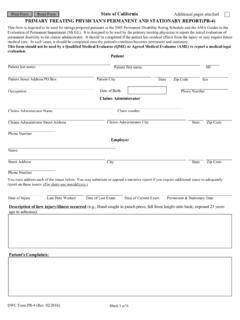Transcription of U.S. China Biotech Report - Homepage | U.S.- CHINA
1 CHINA s Biotechnology Development: The Role of US and Other Foreign Engagement A Report prepared for the Economic and Security Review Commission February 14, 2019 Gryphon Scientific, LLC 6930 Carroll Avenue, Suite 810 Takoma Park, Maryland 20912 Mark Kazmierczak, Ryan Ritterson, Danielle Gardner Rocco Casagrande, 301-270-0374 Rhodium Group, LLC 5 Columbus Circle New York, NY 10019 Thilo Hanemann Daniel H. Rosen 212-247-3997 Disclaimer: This research Report was prepared at the request of the Economic and Security Review Commission to support its deliberations. Posting of the Report to the Commission's website is intended to promote greater public understanding of the issues addressed by the Commission in its ongoing assessment of economic relations and their implications for security, as mandated by Public Law 106-398 and Public Law 113-291.
2 However, it does not necessarily imply an endorsement by the Commission or any individual Commissioner of the views or conclusions expressed in this commissioned research Report US Role in CHINA s Biotechnology Development i CONTENTS Executive Summary 2 Introduction 9 1. CHINA s Biotechnology Sector 12 Current State of CHINA s Biotechnology Industry by Segment .. 13 The Biotechnology Market at a Glance .. 13 Biologics (Biopharmaceuticals) .. 15 Genomics, Molecular Diagnostics, and Precision Medicine .. 25 Agricultural Biotechnology .. 27 Industrial Biotechnology .. 33 CHINA s Plans and Goals for Biotechnology .. 35 CHINA s Science and Technology Programs .. 35 The Strategic Emerging Industries Initiative .. 36 The 12th and 13th Five-Year Plans.
3 36 Made in CHINA 2025 .. 38 Talent Programs .. 38 Biotechnology Parks .. 39 Local level Policies .. 40 Comparison of Chinese and US Biotechnology Programs .. 41 Comparison of Industrial Policies .. 41 Comparison of Biotechnology Spending .. 41 Outlook .. 42 2. The Role of Foreign Firms and Technologies in CHINA s Biotechnology Development 45 Foreign Investment in CHINA .. 46 Direct Investment .. 46 Venture Capital and Other Portfolio Investment .. 49 Overseas Listings .. 53 Chinese Outbound Investment .. 55 Direct Investment .. 55 Venture Capital and Other Portfolio Investment .. 59 Other Channels .. 62 Patent Acquisitions and Licensing .. 62 Research Partnerships and other Collaborations .. 63 Overseas Scientists .. 66 Espionage and Other Illicit Activities.
4 68 Regulatory Supervision of Foreign Interaction with Chinese Biotech Firms and Individuals .. 71 3. Chinese Investment in the US Biotechnology Industry 73 Annual Flows and Stock .. 74 Entry Mode .. 76 Investor Mix .. 77 By Segments .. 80 Biologics .. 82 Contract Research or 85 Genomics and Related Technologies .. 87 Molecular Diagnostics and Precision Medicine .. 89 Research/Discovery Platforms, Tools and Support Products .. 91 US Role in CHINA s Biotechnology Development ii Industrial Bioproduction and Bioprocessing .. 92 Agricultural or Agriculture-Applicable Biotechnology .. 94 Biotech Incubators/Accelerators .. 96 US Regulation of Foreign Investment .. 97 Outlook .. 100 4. CHINA s Involvement in Research Organizations 103 Types of Partnerships.
5 103 Research and Development Centers .. 104 Biotechnology Incubators .. 105 Other partnerships .. 106 Chinese Students and Academic Research in the US .. 107 CHINA s Talent Programs .. 107 University partnerships .. 109 Benefits and Risks .. 110 Role of government in regulating international research .. 112 5. CHINA s Access to Healthcare-Related Data 115 Healthcare Data and Biotechnology .. 115 Genomic Data .. 116 CHINA s Investments in Modernizing Collection of Healthcare Data .. 117 CHINA s Improvements in Data Infrastructure .. 119 Channels of Access to US Healthcare Data .. 120 Chinese Investment in US Healthcare Data Companies .. 120 Chinese-US Partnerships .. 122 CLIA Certification of Chinese Companies .. 123 Data Protections and Security Concerns.
6 125 Data Oversight and Protection Laws .. 126 Access to US Personal Data by CHINA .. 131 Conclusions and Recommendations 137 Methodology Appendix 142 Investment Data .. 142 Data Coverage .. 142 Qualifications and Caveats .. 143 Bibliometric Analysis .. 144 Identification of CLIA Certified Genetic Testing Laboratories in the US and CHINA .. 145 University Partnerships .. 145 List of Abbreviations 146 US Role in CHINA s Biotechnology Development 2 Executive Summary American policymakers have a keen interest in understanding the interaction between the US biotechnology sector and industry developments in CHINA . This high-technology complex is key to economic competitiveness and national security in the years ahead. The US is today the leading Biotech nation in the world, a position earned through a century of innovation and healthy market conditions that fostered success.
7 CHINA , meanwhile, is an increasingly important player in biotechnology, given a huge population and effort to advance, and it has great potential to lessen the gap with the US in certain areas. Collaboration with America through investment, education, trade, R&D, and talent flows was critical to CHINA s Biotech catch up since the 1980s. The current flow of capital, people, and ideas between the Chinese and US Biotech industries reflects the reality of increasing economic globalization that creates benefits to both sides but has recently come under debate given concerns that CHINA s economic, political, and security evolution is not as aligned with American interests as previously assumed. As a major element of CHINA s biotechnology growth, Chinese Biotech companies are utilizing US firms to acquire technologies and data that bolster their current capabilities through a variety of channels, including bi-directional investment, corporate and academic partnerships, and recruitment of US-trained researchers (both foreign- and Chinese-born).
8 A leading segment of CHINA s biotechnology industry going forward will use big data in healthcare with technologies such as genomics and precision medicine. Through investments and research partnerships with US institutions, Chinese biotechnology companies are acquiring technologies crucial to advancement in the field as well as amassing large collections of clinical and genetic data on US residents. This Report reviews the development of CHINA s biotechnology industry and the role foreign trade, investment and other linkages particularly with the United States have played in its evolution. We find that integration and collaboration run deep, and that disrupting these linkages would bring high costs for innovation, US welfare and public wealth. Continued investment by the US in its own biotechnology industry will go a long way toward limiting the effectiveness of CHINA s efforts to close the biotechnology gap between the two countries.
9 At the same time, the US needs to address concerns arising from CHINA s current policy directions, including better screening of investment and other engagements for potential national security risks and the protection of sensitive data. Our key findings are summarized below. The development of CHINA s Biotech industry CHINA s Biotech industry has grown rapidly over the past decade but still remains less than a tenth the size of the US Biotech industry in terms of market size. CHINA s biologics market is estimated at 30 to 40 billion yuan ($ to $ billion) and their agricultural Biotech market is around $ billion, while estimates places those US markets at $118 billion and $110 billion, respectively. Overall, the US maintains a superior biotechnology innovation capacity through world-class research training and strong governmental support of R&D, but CHINA is seeking to close that gap through its top-down government strategy and coordination, talent recruitment programs, high R&D spending across the industry, and capacity for high-tech R&D.
10 CHINA s biotechnology sector is dominated by biologics and other medical technologies. As with other parts of the world, this segment is growing quickly due to rising demand from patients and the high value of the products relative to traditional pharmaceuticals. CHINA s products, however, are largely biosimilars rather than innovative new biologic products. Contract research and manufacturing also make up much of the segment. Though these activities represent a low end of the biotechnology value chain, they are nonetheless high-tech and high-skill, and build a solid foundation of technology for future innovation. Chinese biopharmaceutical companies are developing some innovative biologics using cutting-edge technologies such as Chimeric Antigen Receptor T-cell therapy (CAR-T) and CRISPR (Clustered Regularly Interspaced Short Palindromic Repeats)-based editing of cells, both of which can be used to treat cancer.



